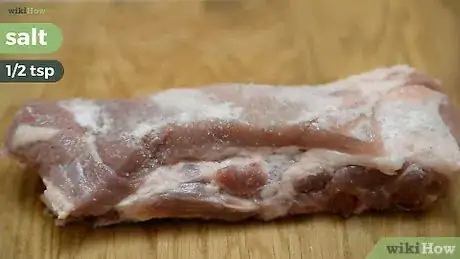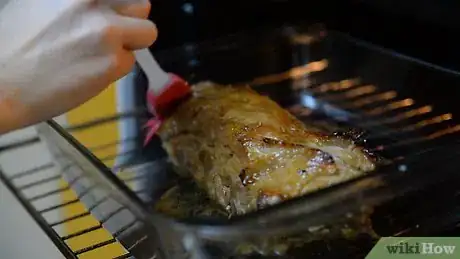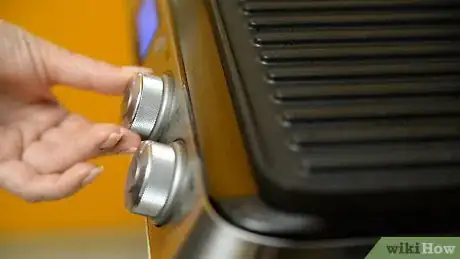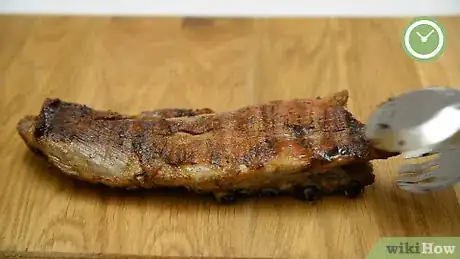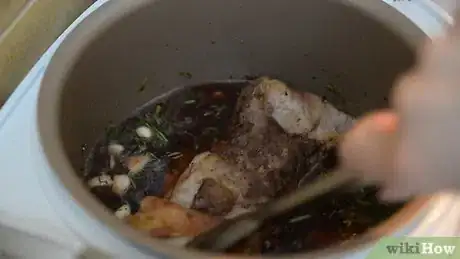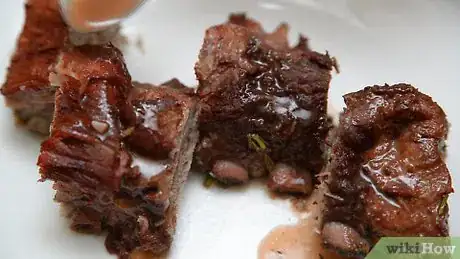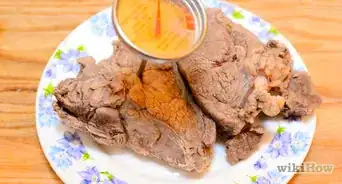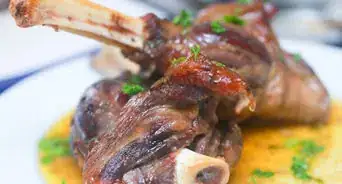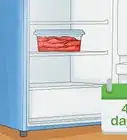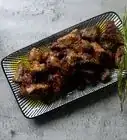This article was co-authored by wikiHow Staff. Our trained team of editors and researchers validate articles for accuracy and comprehensiveness. wikiHow's Content Management Team carefully monitors the work from our editorial staff to ensure that each article is backed by trusted research and meets our high quality standards.
The wikiHow Video Team also followed the article's instructions and verified that they work.
This article has been viewed 249,537 times.
Learn more...
Lamb spare ribs are an uncommon, yet tasty, cut of meat. You can cook them in several different ways, including the oven, grill, and slow cooker. The trick to getting them just right, however, is the seasoning. Once you know what flavors go well with lamb, the cooking possibilities and combinations are endless!
Ingredients
Roasted Lamb Spare Ribs
- 2 to 3 racks of lamb spare ribs
- 1/2 teaspoon of salt
- 1⁄2 cup (120 mL) of balsamic vinegar
- 1/4 cup (90 g) of honey
Marinade
- 3⁄4 cup (180 mL) of balsamic vinegar
- 3⁄4 cup (180 mL) of olive oil
- 3 tablespoons of garlic, smashed
- 3 tablespoons of fresh rosemary, chopped
Serves 6 to 8
Grilled Lamb Spare Ribs
- 4 racks of lamb spare ribs, well-trimmed and cut in half
- Olive oil, for brushing
- Kosher salt, to taste
- Freshly ground pepper, to taste
Marinade
- 2 cups (470 mL) of sherry vinegar
- 1⁄2 cup (120 mL) of fresh lemon juice
- 1/2 cup (13 g) chopped rosemary sprigs
- 6 garlic cloves, thinly sliced
Serves 8
Slow Cooker Lamb Spare Ribs
- 2 racks of lamb spare ribs
- 3 tablespoons (45 mL) of olive oil
- 2 tablespoons of chopped fresh rosemary
- 1 tablespoon of chopped fresh thyme
- 1 1⁄4 cups (300 mL) of red wine
- 1/4 cup (80 g) of plum jam
- 1 teaspoon of lemon zest
- 3 cloves of garlic, roughly chopped
- 1 teaspoon of minced ginger
Serves 8
Steps
Oven
Pour 3⁄4 cup (180 mL) of balsamic vinegar into a bowl. Add 3⁄4 cup (180 mL) of olive oil, 3 tablespoons of smashed garlic cloves, and 3 tablespoons of chopped fresh rosemary. Stir everything together with a whisk until the oil and vinegar bind together.
-
1
- To smash the garlic, peel a clove, then press it against a cutting board with the flat side of a knife. Do this until you have enough to fill 3 tablespoons.
- You can use a different marinade, if you prefer. It can be homemade or store-bought.
-
2Season the lamb spare ribs with salt. Sprinkle about 1/2 teaspoon of salt over the ribs, then use your hands to massage the salt into the meat as evenly as possible.[1]
-
3Refrigerate the ribs in the marinade for 6 to 8 hours. Pour the marinade into a shallow dish, then add the ribs, ensuring that they are fully submerged. Cover the dish with plastic wrap, then stick it into the fridge. Leave it there for at least 6 hours, preferably overnight.[2]
- Alternatively, transfer everything into 1 or 2 large, resealable plastic bags. Be sure to seal the bag(s) tightly.
-
4Combine the honey and vinegar to make the glaze. Pour 1⁄2 cup (120 mL) of balsamic vinegar into a bowl. Add 1/4 cup (90 g) of honey and stir it with a whisk. Set the bowl aside for later; this will be your basting glaze.[3]
- You can use a different basting glaze. Do not reuse the marinade, however.
- You do not need to refrigerate this glaze. Honey and vinegar can stand at room temperature.
-
5Bake the ribs in a preheated oven at 325 °F (163 °C) for 1 hour. Preheat your oven to 325 °F (163 °C). Once the oven reaches the correct temperature, take the ribs out of the marinade and arrange them in a shallow roasting pan. Place the pan into the oven and allow the ribs to bake for 1 hour.[4]
- Discard any leftover marinade. Do not save it for another recipe.
- The ribs won't be fully cooked on the inside at this point; you're not done baking them.
-
6Turn the ribs, baste them with the glaze, and bake them for 30 minutes. Turn the ribs over with a pair of metal tongs. Use a basting brush to coat them with the honey-vinegar glaze, then bake them for 30 minutes. Every 5 to 10 minutes, baste the ribs with more honey-vinegar.[5]
- Discard any leftover glaze once the baking time is up.
-
7Let the ribs rest for 5 minutes, then cut them ribs into 6 or 8 servings. Use a pair of tongs to take the ribs out of the roasting pan first, and transfer them to a cutting board. Cut them into portions using a sharp knife, then serve them.[6]
- Each portion should contain 2 to 3 ribs.
- Allowing the ribs to rest for 5 minutes will help them finish cooking on the inside.
- Wrap any leftover ribs in foil and put them into the fridge. Eat them within 3 days.
Grill
-
1Combine the vinegar, lemon juice, rosemary, and garlic in a bowl. Pour 2 cups (470 mL) of sherry vinegar into a mixing bowl. Add 1⁄2 cup (120 mL) of fresh lemon juice, 1/2 cup (13 g) of chopped rosemary sprigs, and 6 thinly sliced garlic cloves. Stir everything together with a whisk.[7]
- This will be your marinade. If you have a different marinade that you prefer, prepare that instead.
-
2Marinate the ribs in the mixture for 1 hour at room temperature. Divide the marinade between 2 large Ziploc bags, then place 2 racks of lamb spare ribs into each bag. Seal the bags tightly, then leave them on the counter for 1 hour.[8]
- Make sure that the ribs are fully coated with the marinade. If you need to, roll them over a few times.
- After about 30 minutes, flip the bags over. This will help ensure that both sides of the ribs sit in the marinade for an equal amount of time.
-
3Preheat your grill to medium-high heat. How you do this depends on the type of grill that you have. Refer to the manual that came with your grill, if needed. It needs to be hot and ready by the time you put the ribs on it.[9]
- Gas grill: turn the burners to "high" and wait 15 minutes. Turn the middle burners off and reduce the rest to medium-high heat.
- Charcoal grill: burn 50 briquettes until they turn light gray. Put them into 2 piles on each side of the grate with a drip pan between them. Set a grill grate on top.
-
4Scrape off the garlic and rosemary and pat the ribs dry. Take the ribs out of the marinade and set them down on a cutting board. Use a knife to gently scrape the rosemary and garlic off of the ribs. Use paper towels to pat the ribs dry.[10]
- Discard any leftover marinade. Do not reuse it; it's been in contact with raw meat.
-
5Brush olive oil onto the ribs, then season them with some salt and pepper. Pour some olive oil into a small bowl. Use a basting brush to coat both sides of the ribs with the olive oil. Sprinkle salt and pepper onto both sides of the ribs.[11]
- Discard any leftover olive oil. It's been contaminated by the basting brush and ribs.
- How much salt and pepper you use is up to you.
-
6Grill the ribs for 10 to 12 minutes, turning them once. Set the ribs on the grill and cook them for about 5 to 6 minutes. Use a pair of metal tongs to turn the ribs over. Let them cook for another 5 to 6 minutes.[12]
- The ribs are ready when they are charred on the outside, and medium-rare on the inside.
-
7Let the ribs rest for 5 minutes before you serve them. Use a sharp knife to cut them into smaller serving portions. They taste great with chimichurri, but if you used a different marinade, you can serve them with a different sauce whose flavor complements it better.[13]
- For example, if you used a Greek or Mediterranean marinade, you could serve the ribs with tzatziki.
- Wrap leftover ribs in foil. Store them in the fridge, and enjoy them within 3 days.
Slow Cooker
-
1Brown the lamb racks in a frying pan and oil for 1 to 2 minutes per side. Heat about 1 tablespoon (15 mL) of olive oil in a frying pan over high heat. Add the lamb racks, and cook them for 1 to 2 minutes on each side until they are lightly browned. Use tongs to remove the racks, and transfer them to a plate.[14]
- Browning the lamb racks first will help seal the juices in and give you a more tender meal.
- If your pan is small, you may have to do this step twice, once for each rack.
-
2Place the rest of the olive oil and fresh herbs into the slow cooker. You'll need tablespoons (30 mL) of olive oil, 2 tablespoons of chopped fresh rosemary, and 1 tablespoon of chopped fresh thyme.[15]
- If you have a different recipe that you'd prefer to use, add those ingredients into the cooker instead.
-
3Add the red wine, plum jam, lemon zest, garlic, and ginger. Pour 1 1⁄4 cups (300 mL) of red wine into the cooker. Add 1/4 cup (80 g) of plum jam, 1 teaspoon of lemon zest, 3 cloves of roughly chopped garlic, and 1 teaspoon of minced ginger.[16]
- If you are using a different recipe, then use those ingredients instead.
-
4Put the lamb racks into a slow cooker. Gently toss them with the ingredients so that they are evenly coated and submerged. If the racks are too large to fit into the slow cooker, then cut them into halves, thirds, or fourths as needed.[17]
- Make sure that the slow cooker is sitting on a heat-safe surface. A granite or tile countertop is fine, but a linoleum countertop isn't because it will warp.
-
5Cook the racks on low for 6 to 8 hours. Turn the slow cooker on and set the heat to low. If it is an automatic cooker, it will turn off after about 6 to 8 hours; otherwise, set the timer on it.[18]
- The lamb may absorb some of the wine as it cooks. If that happens, just add a splash of wine to replace what was lost.
- Slow and steady is the key for lamb ribs. Don't use high heat to save time.
-
6Serve the lamb racks. Open the slow cooker carefully so that the steam doesn't hit your face. Use a pair of metal tongs to lift the racks out of the cooker and set them on a serving platter. Cut them into smaller serving portions with a sharp knife. Use a ladle to scoop out some of the sauce, if desired.[19]
- You don't need to let the lamb racks rest for 5 minutes like you normally would with baking or grilling.
- Cover and store any leftover ribs in the fridge, and eat them within 3 days.
Community Q&A
-
QuestionI am putting them on late, so I don't have the 8 hours to cook them on low. Can I put them on high for half the time?
 Community AnswerYou can, but you will not achieve the best results, as the ribs will come out more dry than juicy, and possibly even burnt.
Community AnswerYou can, but you will not achieve the best results, as the ribs will come out more dry than juicy, and possibly even burnt. -
QuestionAre lamb ribs tough?
 Drew Hawkins1Community AnswerLamb ribs can definitely be tough if they aren't cooked properly. Because the ribs are a naturally tougher cut of meat, it's best to cook them for a long time on a relatively lower temperature so the meat tenderizes. For instance, you could season up some lamb ribs the way you like them and then bake them in a preheated oven at 325 °F (163 °C) for 1 hour. Then, turn the ribs over with a pair of metal tongs, and bake them for another 30 minutes so they're so tender they fall off the bone. Basically, the key to lamb ribs to be patient and give them enough time to cook until they're tender.
Drew Hawkins1Community AnswerLamb ribs can definitely be tough if they aren't cooked properly. Because the ribs are a naturally tougher cut of meat, it's best to cook them for a long time on a relatively lower temperature so the meat tenderizes. For instance, you could season up some lamb ribs the way you like them and then bake them in a preheated oven at 325 °F (163 °C) for 1 hour. Then, turn the ribs over with a pair of metal tongs, and bake them for another 30 minutes so they're so tender they fall off the bone. Basically, the key to lamb ribs to be patient and give them enough time to cook until they're tender. -
QuestionDoes lamb get more tender the longer you cook it?
 Drew Hawkins1Community AnswerDefinitely, but it's also important how you cook it. Lamb is naturally tougher meat in general, so to tenderize it, you'll want to either stew the meat for a long period of time or slow-roast it until the muscle fibers relax into a state of juice, delicious tenderness. A simple way to roast lamb is to season it well and place it in a baking dish. Slide the lamb into a preheated oven at 325 °F (163 °C) for 1 hour. Then, rotate the lamb and let it bake for another 30 minutes. After that, check to see how tender the meat is. If it's still tough and doesn't come apart easily, bake it for another 30 minutes. Be patient and give the lamb the time it needs to tenderize.
Drew Hawkins1Community AnswerDefinitely, but it's also important how you cook it. Lamb is naturally tougher meat in general, so to tenderize it, you'll want to either stew the meat for a long period of time or slow-roast it until the muscle fibers relax into a state of juice, delicious tenderness. A simple way to roast lamb is to season it well and place it in a baking dish. Slide the lamb into a preheated oven at 325 °F (163 °C) for 1 hour. Then, rotate the lamb and let it bake for another 30 minutes. After that, check to see how tender the meat is. If it's still tough and doesn't come apart easily, bake it for another 30 minutes. Be patient and give the lamb the time it needs to tenderize.
Things You'll Need
Roasting Lamb Spare Ribs in the Oven
- Mixing bowls
- Whisk
- Plastic wrap or resealable bag
- Basting brush
- Roasting pan
- Measuring cups
- Measuring spoons
- Oven
- Metal tongs
Grilling Lamb Spare Ribs
- Mixing bowls
- Whisk
- Plastic wrap or resealable bag
- Basting brush
- Measuring cups
- Measuring spoons
- Grill
- Metal tongs
Using a Slow Cooker
- Frying pan
- Whisk
- Metal tongs
- Slow cooker
References
- ↑ http://www.geniuskitchen.com/recipe/lamb-spareribs-125710
- ↑ http://www.geniuskitchen.com/recipe/lamb-spareribs-125710
- ↑ http://www.geniuskitchen.com/recipe/lamb-spareribs-125710
- ↑ http://www.geniuskitchen.com/recipe/lamb-spareribs-125710
- ↑ http://www.geniuskitchen.com/recipe/lamb-spareribs-125710
- ↑ http://www.geniuskitchen.com/recipe/lamb-spareribs-125710
- ↑ https://www.foodandwine.com/recipes/grilled-lamb-ribs-with-chimichurri
- ↑ https://www.foodandwine.com/recipes/grilled-lamb-ribs-with-chimichurri
- ↑ https://www.foodandwine.com/recipes/grilled-lamb-ribs-with-chimichurri
- ↑ https://www.foodandwine.com/recipes/grilled-lamb-ribs-with-chimichurri
- ↑ https://www.foodandwine.com/recipes/grilled-lamb-ribs-with-chimichurri
- ↑ https://www.foodandwine.com/recipes/grilled-lamb-ribs-with-chimichurri
- ↑ https://www.foodandwine.com/recipes/grilled-lamb-ribs-with-chimichurri
- ↑ http://allrecipes.co.uk/recipe/34820/slow-cooker-rack-of-lamb.aspx
- ↑ http://allrecipes.co.uk/recipe/34820/slow-cooker-rack-of-lamb.aspx
- ↑ http://allrecipes.co.uk/recipe/34820/slow-cooker-rack-of-lamb.aspx
- ↑ http://allrecipes.co.uk/recipe/34820/slow-cooker-rack-of-lamb.aspx
- ↑ http://allrecipes.co.uk/recipe/34820/slow-cooker-rack-of-lamb.aspx
- ↑ http://allrecipes.co.uk/recipe/34820/slow-cooker-rack-of-lamb.aspx
- ↑ https://www.wine.net/what-wine-goes-with-lamb/
About This Article
You can cook lamb spare ribs in the oven to make a delicious meal. First, mix together balsamic vinegar, olive oil, garlic, and rosemary to make the marinade. When the marinade is done, season the lamb spare ribs using a light sprinkle of salt and then refrigerate the ribs in the marinade for 6 to 8 hours. In the meantime, combine honey and vinegar to make the glaze. Then, remove the ribs from the refrigerator when the time is up and place them in the oven for 1 hour at 325-degrees Fahrenheit, using a shallow roasting pan. After 1 hour, baste the ribs with the glaze and then return them to the oven for a further 30 minutes to finish cooking. For more information on cooking lamb spare ribs, like how to grill ribs, read on!
